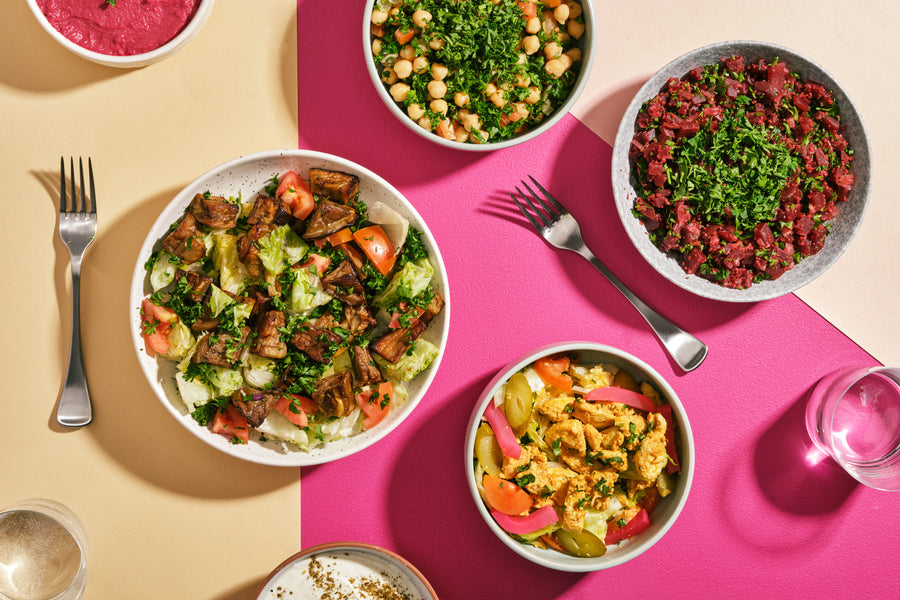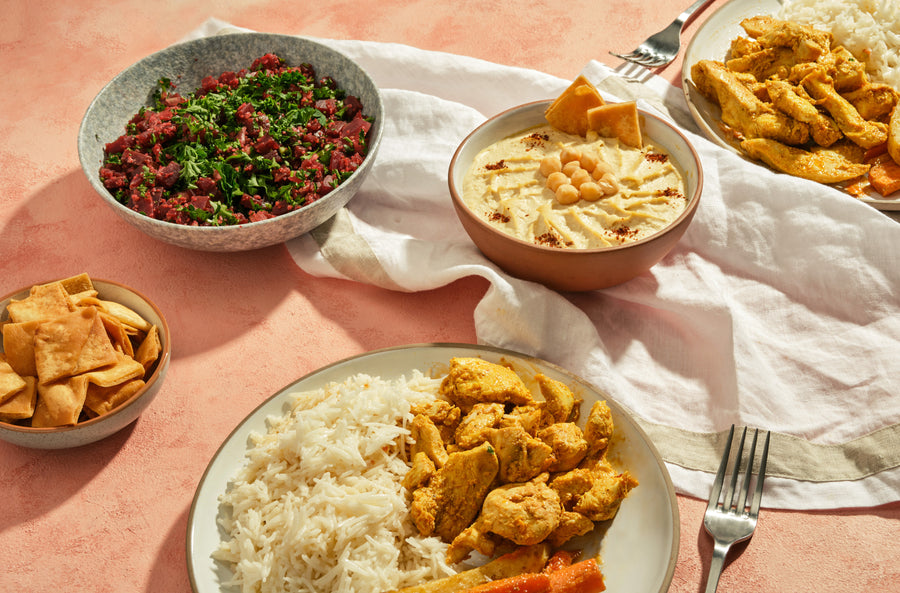BBQ Halal Food Recipes to Impress at Your Next Backyard Feast
A Deep Dive Into Syrian Food: Understanding Its Cultural Importance and Halal Facets
Syrian cuisine personifies a rich tapestry of historic stories and cultural influences. Each dish tells a tale of community and practice, emphasizing the relevance of shared meals. The adherence to halal techniques not only shows faiths but likewise shapes the identification of Syrian food preparation. As global events challenge these cooking customs, the resilience of this cuisine remains a centerpiece of cultural conservation. What exists behind the tastes that define this withstanding heritage?
The Historic Origins of Syrian Cuisine
Syrian cuisine has developed over centuries, its historic origins are deeply linked with the area's diverse social influences. Positioned at the crossroads of various civilizations, Syria has actually soaked up culinary methods from the Phoenicians, Greeks, Romans, and Ottomans, among others. This abundant tapestry of background has actually added to a food identified by a mix of tastes, flavors, and cooking strategies. The fertile lands of the area have likewise played a necessary function, supplying an abundance of grains, fruits, and vegetables that create the foundation of many dishes. The introduction of brand-new components through profession and occupation additionally enhanced the cooking landscape, enabling the advancement of special local specialties. Additionally, the influence of bordering countries has resulted in a vibrant exchange of culinary concepts, solidifying Syria's placement as a substantial player in the wider context of Center Eastern gastronomy.

Conventional Syrian Meals and Their Cultural Importance
Conventional Syrian meals are not just culinary staples yet also carry deep cultural value, showing the nation's abundant heritage. Iconic dishes, frequently prepared throughout joyful celebrations, offer as a way of uniting family members and areas. These dishes personify the tastes of Syria while strengthening social bonds with shared events and practices.
Iconic Syrian Staples
When checking out the rich tapestry of Syrian cuisine, one uncovers a selection of legendary meals that not only entice the taste buds however also symbolize the country's cultural heritage. Among these staples, Kabsa attracts attention as a fragrant rice dish, usually experienced with seasonings like saffron and cardamom, representing hospitality. Fattoush, a dynamic salad made with combined greens and crispy bread, reflects the relevance of fresh ingredients in Syrian cooking. Muhammara, a spicy dip made from peppers and walnuts, showcases the abundant flavors characteristic of the area. Furthermore, Kibbeh, a meal made from bulgur and minced meat, is usually considered as a nationwide prize, standing for public events. Each recipe tells a tale, attaching people to their origins and customs.
Cheery Meal Traditions
Syrian joyful dish practices are rich with importance and value, as households gather to celebrate vital celebrations through the sharing of precious recipes. Dishes commonly display a range of typical foods, with recipes like kibbeh, tabbouleh, and mansaf taking spotlight. Each dish lugs cultural history; as an example, kibbeh, made from bulgur and minced meat, represents friendliness and abundance. Throughout Ramadan and Eid, family members prepare special sweets such as maamoul, symbolizing pleasure and unity. These events foster neighborhood bonds, as sharing a meal indicates love and togetherness. The prep work and pleasure of these dishes mirror Syria's varied culinary heritage, linking household custom-mades and regional impacts, consequently enriching the cheery experience and protecting social identity.
The Role of Family and Community in Syrian Food Society
Food works as an essential string that weaves together household and community in Syrian culture. Meals are usually public experiences, where families collect around a table to share standard recipes that show their heritage. The preparation of food is a common activity, with generations working side by side, giving dishes and food preparation strategies. This practice reinforces familial bonds and promotes a sense of belonging within the community.Special celebrations and religious celebrations further highlight the significance of food in Syrian culture. During these events, family members prepare elaborate dishes that offer not just to nourish however likewise to share love and friendliness. The act of sharing food symbolizes unity and assistance amongst neighbors and friends, strengthening social connections. Via these shared culinary experiences, Syrians grow a strong identity rooted in their abundant social background, illustrating exactly how food transcends mere sustenance to become a crucial part of their social material.
Halal Practices in Syrian Cooking
In the context of common meals and family events, halal techniques play a substantial function in Syrian food preparation. These techniques come from Islamic dietary laws, making sure that food is ready and consumed in a way that aligns with religions. For several Syrian households, adherence to halal concepts influences different facets of dish preparation, from sourcing active ingredients to cooking methods.Animals utilized for meat should be slaughtered according to specific standards, highlighting humane therapy and invoking the name of Allah. In addition, cross-contamination with non-halal products is carefully stayed clear of in both home cooking areas and business establishments.This dedication to halal not just reflects spiritual devotion but likewise cultivates a sense of area, as households usually come with each other to share dishes that recognize these traditions - Brunch Kitsilano Vancouver BC. As a result, halal practices are deeply woven into the fabric of Syrian culinary society, shaping both day-to-day life and cheery occasions
Components That Specify Syrian Flavors

The significance of Syrian food is formed by an unified blend of essential spices and natural herbs that enhance its distinctive tastes. Conventional cooking methods better raise these components, showcasing the abundant cooking heritage of the area. An introduction of essential active ingredients discloses the fundamental duty they play in developing authentic Syrian recipes.
Key Spices and Herbs
A dynamic tapestry of flavors identifies Syrian food, with key spices and natural herbs playing an important function in defining its significance. Noticeable amongst these are sumac, coriander, and cumin, which provide depth see this page and warmth to different meals. Cumin, with its nutty fragrance, typically boosts stews and smoked meats, while coriander adds a why not try these out citrusy note to salads and dips. Sumac, recognized for its tangy flavor, lightens up recipes and is frequently sprayed over fattoush or kebabs. Additionally, cinnamon and allspice give a subtle sweetness, generally located in both tasty and pleasant prep work. Fresh natural herbs like mint, parsley, and dill are additionally crucial, using a burst of freshness and balancing the rich, complicated tastes that make Syrian cuisine unique.
Standard Food Preparation Techniques
Food preparation techniques in Syrian food show an ingrained tradition that enhances the flavors of its components. Methods such as slow-cooking and braising are typically employed, enabling herbs and spices to fuse perfectly with meats and vegetables. Grilling, specifically over charcoal, imparts a smoky splendor to dishes like kebabs, while steaming is often utilized for rice, maintaining its appearance and taste. Additionally, sautéing is favored for preparing aromatic bases, usually starting with onions and garlic to develop depth. Fermentation contributes in creating one-of-a-kind tastes, obvious in dishes like pickled vegetables. These strategies not just highlight the top quality of active ingredients however additionally symbolize the common spirit of cooking, bringing households with each other around shared meals soaked in tradition.
Necessary Ingredients Review
While discovering Syrian cuisine, one rapidly discovers that important components play a crucial role in defining its one-of-a-kind tastes. Olive oil, a staple, supplies richness and depth, usually working as a base for numerous meals. Fresh natural herbs, such as mint, parsley, and cilantro, add lively fragrances and preferences, improving the general experience (Brunch Kitsilano Vancouver BC). Seasonings like cumin, coriander, and cinnamon are regularly utilized, adding heat and complexity to meals. Furthermore, look at this site Syrian food heavily includes grains, specifically bulgur and rice, which work as basic elements in different recipes. Pulses, especially lentils and chickpeas, provide both nutrition and appearance. Together, these active ingredients produce the unified balance that characterizes Syrian dishes, mirroring the country's rich cooking heritage and cultural relevance
The Impact of War on Syrian Culinary Practices
The battle in Syria has wrought destruction throughout the country, its influence on culinary customs exposes a complex interaction of durability and adaptation. As areas encountered displacement, standard recipes were modified because of the shortage of ingredients and resources. Households commonly rely upon locally available fruit and vegetables, incorporating new tastes and strategies right into their meals, which led to the appearance of distinct interpretations of traditional dishes.Moreover, the war cultivated a spirit of solidarity amongst displaced chefs and home cooks, who shared their culinary understanding with social media and area kitchen areas. This sharing of recipes not only preserved cultural heritage however likewise produced a sense of belonging among those impacted by the conflict. In spite of the difficulties, the enthusiasm for food continues to be a unifying force, enabling people to preserve their identity and link with their origins, even in exile. Syrian food continues to progress in the middle of adversity, mirroring both a rich background and modern durability.
Often Asked Concerns
What Are Typical Cooking Methods Utilized in Syrian Cuisine?
Typical cooking methods in Syrian cuisine include grilling, baking, sautéing, and cooking. These techniques enhance appearances and flavors, permitting the creation of varied meals that show the region's abundant culinary heritage and customs.
Just How Has Globalization Influenced Syrian Food?

Exist Vegetarian Options in Standard Syrian Dishes?
Vegan alternatives prevail in conventional Syrian meals, including components like chickpeas, vegetables, and lentils. Popular dishes such as Mujadara and Falafel highlight this diversity, suiting various nutritional choices while preserving the rich tastes of the cuisine.
What Beverages Set Well With Syrian Meals?
Beverages that pair well with Syrian dishes consist of mint tea, pomegranate juice, and ayran - Brunch Kitsilano Vancouver BC. These beverages complement the flavors of standard meals, boosting the eating experience while providing invigorating contrasts to the abundant, tasty preferences
How Do Syrians Commemorate Food Throughout Holidays or Festivals?
Syrians celebrate food during vacations and events with sophisticated feasts, often including traditional recipes. Family events emphasize sharing dishes, symbolizing unity and cultural heritage, while special deals with and sugary foods highlight the festive spirit and public pleasure. Standard Syrian dishes are not only cooking staples however also lug deep social value, mirroring the country's rich heritage. When exploring the rich tapestry of Syrian food, one discovers a range of renowned meals that not just entice the taste buds yet likewise symbolize the country's cultural heritage. Syrian joyful meal traditions are abundant with meaning and significance, as family members gather to commemorate essential events with the sharing of beloved dishes. Cooking techniques in Syrian food show an ingrained tradition that enhances the tastes of its components. Vegetarian alternatives are widespread in conventional Syrian recipes, featuring ingredients like lentils, veggies, and chickpeas.